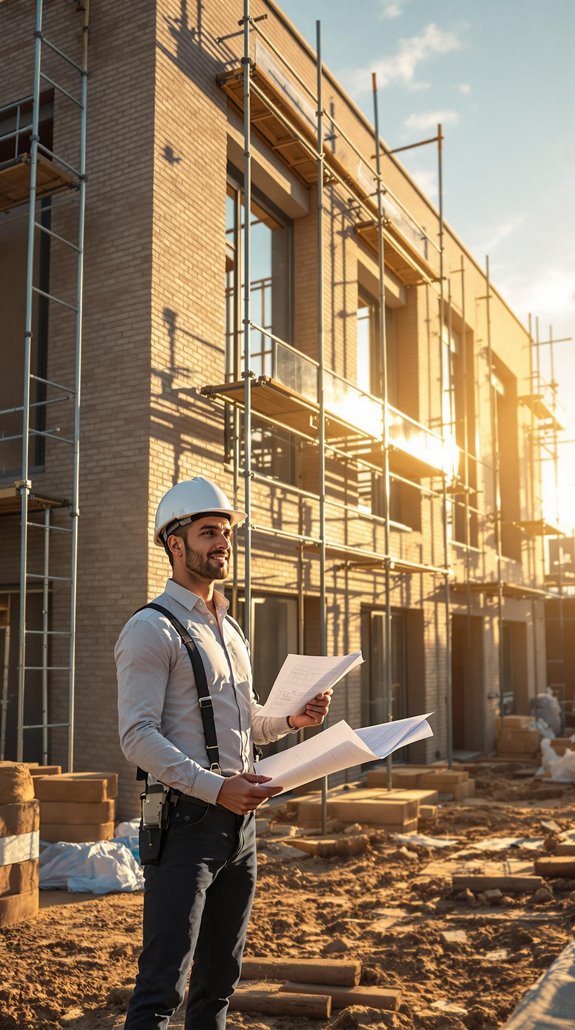I’ll walk you through the VAT reclaim process that could put thousands back in your pocket during your UK new build project. Most homeowners don’t realize they’re entitled to reclaim VAT on qualifying materials and services when constructing their primary residence. The system isn’t straightforward, and there are specific deadlines and documentation requirements that can make or break your claim. Understanding these critical details upfront will determine whether you maximize your savings or miss out entirely.
Key Takeaways
- New builds qualify for 0% VAT rate while renovations attract 20% standard rate, creating significant savings opportunities.
- Reclaim VAT on structural materials like bricks, timber, insulation, plumbing systems, electrical installations, and construction services.
- Submit claims within three months for pre-December 2023 completions or six months for later projects to avoid rejection.
- Property must serve as your primary residence with proper VAT invoices including supplier details and registration numbers required.
- Exclude professional fees, landscaping, decorating works, and electrical blinds as these don’t qualify for VAT reclaim.
Who Qualifies for VAT Reclaim on New Build Properties

Who can actually claim VAT back on new build properties? You’ll qualify if you’re building your own primary residence as an individual. This means the property must serve as your principal private residence – not an investment or rental property. I can’t stress enough that VAT-registered builders don’t use this scheme; they’ve got different reclaim mechanisms.
Your family members living in the property count as eligible beneficiaries, which expands your household’s potential savings. However, if you’re planning to sell immediately after completion, you’ll void your eligibility entirely. Partial home office use won’t disqualify you, but running a full business operation will. Remember that you can only make one VAT claim per project under the DIY VAT Homebuilders Scheme.
Essential Materials and Services You Can Claim VAT Back On
Five main categories of materials and services qualify for VAT reclaim on your new build or conversion project, each covering essential construction elements you’ll need anyway.
Structural components form your building’s backbone – bricks, timber framing, roofing materials, insulation, and concrete mixtures all qualify. Understanding the importance of cost-effective renovations can help maximize your overall investment in the project. Plumbing and heating systems include pipes, boilers, radiators, sanitaryware, and hot water cylinders that you’re installing permanently.
Electrical installations cover wiring, consumer units, fixed lighting, switches, and security systems built into your property. Construction services like bricklaying, electrical installation, plumbing work, and plastering qualify when part of your build contract.
Essential fixtures include fixed kitchen units, doors, windows, staircases, and fire safety systems. For conversions, structural beams and similar materials for transforming derelict buildings also qualify, maximizing your potential savings. Remember that the property must be intended as your primary residence to qualify for VAT reclaim under the scheme.
Critical Deadlines You Must Meet to Secure Your Refund
While the extended deadline provides more breathing room than before, understanding exactly when you must submit your VAT reclaim application determines whether you’ll recover thousands of pounds or lose everything to paperwork delays.
The rules changed on December 5, 2023. If you completed your build before this date, you’ve got three months from completion to submit your claim. Complete your project on or after December 5, 2023, and you get six months.
Your completion date starts when your building becomes ready for habitation – typically when you receive your completion certificate from the local authority. Missing this deadline is the most common reason HMRC rejects claims, with no exceptions granted. The extended timeframe gives you proper opportunity to gather documentation and submit accurately.
HMRC typically processes refunds within one month, though delays may occur if your submission contains errors or incomplete documentation.
Documentation Requirements That Make or Break Your Claim
Meeting your submission deadline means nothing if your paperwork fails HMRC’s strict documentation standards. I’ll show you exactly what documentation saves thousands versus what gets rejected.
Your VAT invoices must include the supplier’s name, address, VAT registration number, unique invoice number, issue date, clear goods/services description, VAT rate applied, and total VAT amount. Don’t accept incomplete invoices – they’re worthless for reclaims. It’s essential to understand that proper documentation can significantly impact your legal fees during the reclaim process.
For purchases under £250, simplified retail receipts work fine. Construction projects need authenticated receipts for stage payments. If original invoices disappear, bank statements proving VAT paid can substitute. The invoice doesn’t need to show your business name if you can prove the purchase was for business purposes.
Store everything digitally using MTD-compliant software, categorized by VAT rates. Keep records six years minimum. Cross-reference payments with bank statements – this verification step catches costly errors before HMRC does.
Step-by-Step Application Process for Maximum Success
Once you’ve organized your documentation, the application process requires methodical execution across five critical phases that determine whether you’ll receive thousands back or face costly rejection.
First, I’ll confirm your project’s eligibility and calculate your deadline window. Pre-December 5th, 2023 completions get three months; post-December projects receive six months from completion. There’s no leeway here—late submissions mean automatic rejection. It’s important to note that new build homes often come with modern designs that can enhance property value.
Next, I’ll select the correct HMRC form (VAT431NB for new builds, VAT431C for conversions) and compile original VAT invoices with completion certificates. Digital copies won’t work. Remember that only VAT-registered businesses can proceed with these claims, so verify your registration status before investing time in the application process.
For submission, I’ll use tracked postal service to BT VAT, BX9 1WR—email submissions aren’t accepted. Finally, I’ll monitor the 4-6 week processing timeline and respond to any HMRC inquiries within ten working days.
Common Exclusions That Could Disqualify Your Project
Before submitting your VAT reclaim application, understanding the exclusions that’ll automatically disqualify your project can save you months of wasted effort and prevent costly mistakes. Professional fees like architectural design, engineering consultancy, and surveyor costs are completely excluded from VAT recovery. Properties intended for business use or rental purposes don’t qualify under the DIY scheme’s residential criteria. You can’t reclaim VAT on electrical blinds, broadband equipment, landscaping, or decorating works. When contractors charge incorrect VAT rates or aren’t VAT-registered, you’ll lose reclaim eligibility entirely. Public infrastructure projects and local authority developments fall outside the scheme’s scope. Projects not classified as new dwellings or qualifying conversions are automatically excluded from consideration. Additionally, maintenance work on existing buildings attracts the standard rate and cannot be reclaimed under the DIY scheme. Understanding the (importance of energy efficiency) in new builds can also impact your overall project costs and potential savings.
Calculating Your Potential VAT Savings on Construction Costs

Calculating Your Potential VAT Savings on Construction Costs
Understanding your potential VAT savings requires calculating the exact reclaim amounts based on your project type and purchasing approach. I’ll show you how to estimate your savings using the framework that applies to your situation.
For new builds, you’ll reclaim 20% on materials you purchase directly. If you’re spending £50,000 on materials, that’s £10,000 back in your pocket. Labor costs from VAT-registered contractors are zero-rated, so there’s no VAT to reclaim but none to pay either. Planning a home extension can also influence your overall project costs, as various factors like size and design complexity come into play.
Conversion projects offer greater reclaim potential. You’ll recover 20% on self-bought materials plus 5% on contractor labor costs. A £100,000 conversion project could yield £5,000 in labor VAT reclaims alone, making conversions particularly attractive for maximizing savings. Remember that detailed invoices and receipts showing VAT paid are essential for supporting your reclaim applications.
Expert Tips to Avoid Costly Mistakes During Your Claim
While VAT reclaim can deliver substantial savings on your construction project, a single mistake in your claim can trigger penalties, delays, and even force you to repay reclaimed amounts with interest.
I’ve seen countless builders stumble on seemingly straightforward requirements. You’ll avoid most pitfalls by maintaining meticulous records for at least six months and ensuring every invoice includes your company details and VAT registration number. Don’t guess at classifications—materials must be integral to your building’s structure, not standalone items. Be aware that leasehold extensions often require additional permissions, which can complicate your project and impact your VAT claim.
The Domestic Reverse Charge trips up many contractors. When both you and your customer are VAT-registered, mark invoices correctly with proper wording. Submit returns punctually to dodge HMRC’s penalty system. Remember that new builds generally qualify for the 0% VAT rate, while renovations typically attract the standard 20% rate.
Most importantly, consult an accountant when uncertain. Professional guidance costs less than rectifying costly mistakes later.
Real-World Examples of Successful VAT Reclaim Projects
Following this expert guidance becomes clearer when you see how real builders have successfully navigated VAT reclaim on actual projects. I’ve witnessed a homeowner reclaim £10,000 from a £50,000 new build by properly documenting materials and submitting Form VAT431NB. Another impressive case involved a church conversion where the owner secured £15,000 back on their £75,000 renovation by proving the building’s non-residential origins with detailed invoices.
Housing associations consistently achieve substantial savings—one multi-unit project reclaimed over £50,000 through proper RRP documentation. Even smaller charitable projects deliver meaningful results: a daycare facility recovered £8,000 on £40,000 spent. Remember that all claims must be submitted within three months of project completion to qualify for the refund. The key pattern I’ve observed? Successful claimants meticulously maintain records, understand eligibility requirements, and submit complete documentation promptly after completion.
Conclusion
I can’t overstate how essential proper VAT reclaim planning is for your new build project. You’ll potentially save thousands if you follow the deadlines, maintain detailed records, and understand what’s claimable. Don’t rush the application process—one missing invoice or incorrect classification can derail your entire claim. I’d recommend starting your documentation from day one and consulting HMRC guidance regularly. Your diligence now translates directly into substantial cost savings later.
References
- https://www.self-build.co.uk/our-guide-claiming-back-vat-self-build/
- https://www.gov.uk/vat-building-new-home
- https://cartwheelinternational.com/blog/reclaim-vat-on-construction-materials-uk/
- https://tspartners.co.uk/unlocking-the-vat-refund-for-self-build-projects-a-guide-for-homebuilders/
- https://www.gov.uk/guidance/claim-a-vat-refund-for-a-new-home-or-charity-building-if-youre-a-diy-housebuilder
- https://www.moorefinancialmanagement.wales/vat-on-self-builds/
- https://www.potton.co.uk/self-build-academy/self-build-knowledge-hub/finance/how-to-reclaim-vat
- https://www.gov.uk/guidance/vat-refunds-for-new-builds-if-youre-a-diy-housebuilder
- https://uaccountancy.co.uk/reclaim-vat/
- https://www.ukpropertyaccountants.co.uk/the-diy-vat-refund-scheme-a-comprehensive-guide/

